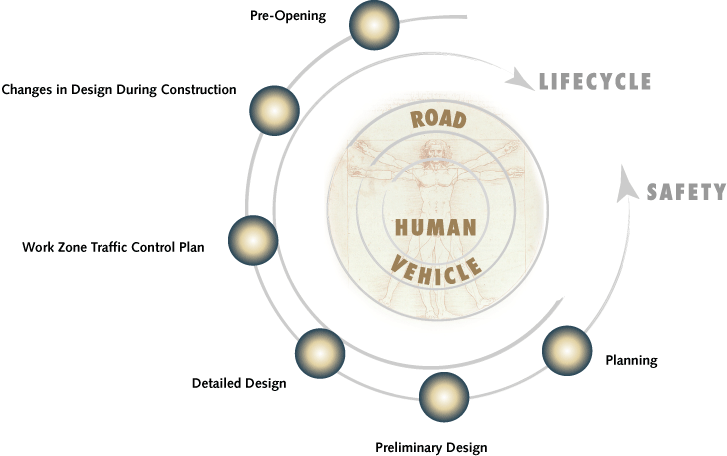Low RSA costs and minimal project delay.
The toll from highway crashes remains an important health and economic issue in the United States. Each year nearly 43,000 individuals are killed and 3 million are injured. The estimated societal cost of these highway crashes is more than $230 billion annually.
The toll from highway crashes remains an important health and economic issue in the United States. Each year nearly 43,000 individuals are killed and 3 million are injured. The estimated societal cost of these highway crashes is more than $230 billion annually.
The Federal Highway Administration (FHWA) of the United States Department of Transportation (USDOT) is strongly committed to continuous improvement in road safety.
FHWA's current efforts reflect its support for new tools such as Road Safety Audits (RSAs), which serve to bring an improved understanding of crash cause and countermeasures to bear in a proactive manner.
Well-documented experience in Europe, Australia, and elsewhere shows that RSAs are both effective and cost beneficial as a proactive safety improvement tool. For example, a Surrey County, United Kingdom, study found that, after implementation, the average number of fatal and injury crashes at project sites that were audited fell by 1.25 crashes per year (from 2.08 to 0.83 crashes per year) while the post-implementation reduction in crashes at comparable, non-audited sites was only 0.26 crashes per year (from 2.6 to 2.34 crashes per year).
Experience with RSAs in the United States indicates that RSA teams often identify safety concerns that would not otherwise have been discovered by a traditional safety review. For example, New York DOT reports a 20% to 40% reduction in crashes at more than 300 high-crash locations treated with low-cost improvements recommended as a result of RSAs.
These safety improvements resulting from RSAs can be achieved at a relatively low cost and with minimal project delay. As PennDOT trials of RSAs indicated, the cost of RSAs is "very little for the amount of success."
Conducting RSAs and implementing their recommended safety improvements in design is estimated to typically cost 5% of overall engineering design fees.
As illustrated in Exhibit 1, conducting RSAs earlier in a road project's lifecycle (e.g. during preliminary design), results in less implementation cost than later in the process, such as during detailed design or construction.
What is a Road Safety Audit?
A Road Safety Audit (RSA) is a formal safety performance examination of an existing or future road or intersection by an independent audit team.
The RSA team considers the safety of all road users, qualitatively estimates and reports on road safety issues and opportunities for safety improvement.
Exhibit 1
RSAs enhance other road safety strategies.
Depending on the size of the project, RSAs, if planned appropriately, require less than 1 week to conduct. The investment is a unique opportunity to draw upon the depth and breadth of knowledge represented by a diverse RSA team and is an excellent opportunity to reflect upon and document engineering decisions made regarding safety.
RSAs build on other road safety improvement strategies and techniques already in place and do not replace them. International experience shows that effective road safety management programs should exercise an optimal balance between reactive and proactive strategies in each jurisdiction, based on local conditions. Public agencies implementing RSAs should view them as one of an integrated range of tools intended to further the goals and objectives of a comprehensive road safety management program.
Most public agencies have established traditional safety review processes through their high hazard identification and correction programs. However, an RSA and a traditional safety review are different processes. It is important to understand the difference.
Viewpoint
"We view RSAs as a proactive, low-cost approach to improve safety. The RSAs helped our engineering team develop a number of solutions incorporating measures that were not originally included in the projects. The very first audit conducted saved SCDOT thousands of dollars by correcting a design problem."
Terecia Wilson, Director of Safety South Carolina Department of Transportation
There is currently a diversity of views and opinions about the appropriate scope, role, and application of RSAs. Recognizing that these differing views and opinions exist, public agencies need to make RSAs work for them. Integrating RSAs within an existing design and safety management framework may require a different approach in each circumstance.
The role of RSAs in overall safety policies and procedures.
However, each RSA conducted should include certain key elements such as the use of an independent, multidisciplinary team and the completion of a response report. The RSA key elements should be applied equally across all possible RSA applications.
Reflecting this philosophy, this guideline provides a foundation for public agencies to draw upon when developing RSA policies and procedures and when conducting RSAs within their jurisdiction. It is hoped that this guideline, developed specifically for application in the United States, will further the integration of RSAs into everyday engineering practice.
| What is the difference between RSA and Traditional Safety Review? | ||
|---|---|---|
| Road Safety Audit | Traditional Safety Review | |
| 1 | Performed by a team independent of the project | The safety review team is usually not completely independent of the design team |
| 2 | Performed by a multi-disciplinary team | Typically performed by a team with only design and/or safety expertise |
| 3 | Considers all potential road users | Often concentrates on motorized traffic |
| 4 | Accounting for road user capabilities and limitations is an essential element of an RSA | Safety reviews do not normally consider human factor issues |
| 5 | Always generates a formal RSA report | Often does not generate a formal report |
| 6 | A formal response report is an essential element of an RSA | Often does not generate a formal response report |

